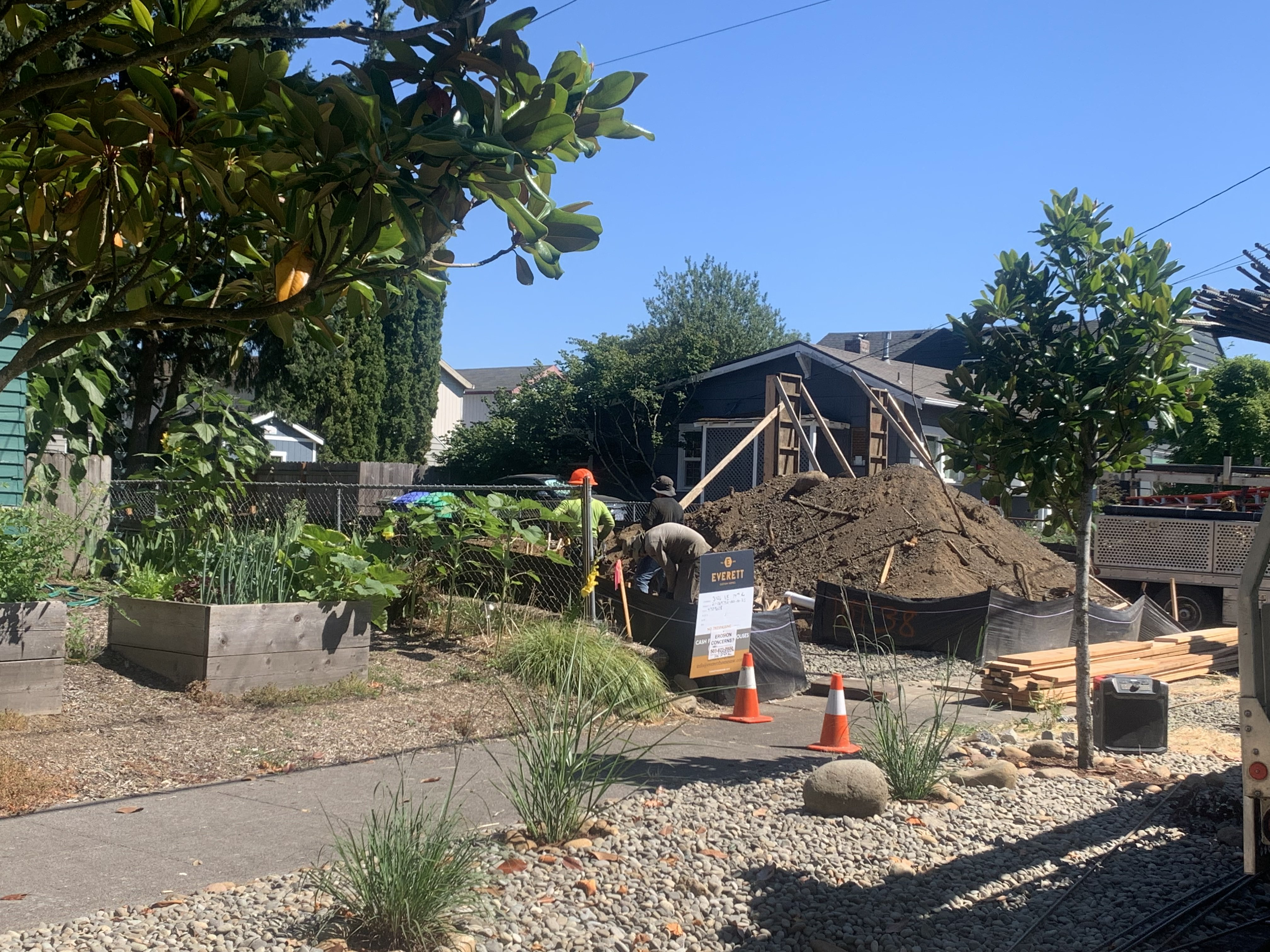By LAUREN DAKE/Oregon Public Broadcasting
Next year marks the 50th anniversary of the creation of Oregon’s land-use system.
The idea behind the rules for where growth can happen was straightforward: preserve rural lands for rivers, farms and forests and save the development for urban areas within what are now called urban growth boundaries.
Signs of the system’s success span the state: farmland in Madras that stretches to the horizon, massive Douglas Firs that dominate the Willamette National Forest and a urban core in Portland that is dense enough to allow commuters to bike or ride mass transit to work.
But Oregon’s unique approach to growth also created unintended consequences: it’s been overly burdensome and bureaucratic, discriminatory or simply failed to deliver.
One of its stated goals, for example, is to have enough homes at a range of prices and rent levels that meet the financial capabilities of Oregonians.
Today the housing shortage is evident in every corner of the state: skyrocketing single-family prices homes in Bend and Hood River, a dwindling middle class and thousands of people who are without a home.
Josh Lehner, a state economist, said some estimates show the state is short 111,000 housing units, primarily those that would help lower-income families.
Pro-development groups point to the housing crisis as proof it’s time to overhaul Oregon’s land-use system. Allowing more land to be developed — putting more land inside the urban growth boundaries — would, the argument goes, decrease the cost of single-family homes by increasing the amount available. Conservation groups argue, however, that plenty of land exists inside the urban growth boundary that could be developed. The answer is more density, they say, not less.
In the next 50 years, as the population of the state continues to surge, Oregon will inevitably start to look very different. The next governor will be instrumental in determining how much money is spent on housing; she will appoint the agency heads and key commissioners charged with implementing housing policies, and she will have the power to convene those who determine what land is developed and where.
“The housing policy in this state is really the prime responsibility of the governor,” said Dave Hunnicutt, president of the Oregon Property Owners Association. ”We are not a state that tolerates local control over housing decisions and delegates that to the cities and counties; the state has assumed that role and the governor as the chief executive officer of the state sets that policy.”
When it comes to how we manage our land in Oregon, the three candidates for governor have very different perspectives and depending on who is elected, our state’s landscape could look very different in the next half century.

Kotek promises more aggressive action
No lawmaker in recent history has been more influential when it comes to statewide housing policies than Tina Kotek.
While serving as speaker of the Oregon House, Kotek ushered through legislation to pass the nation’s first statewide rent control bill, preventing landlords from raising rents beyond a certain percent each year. She pushed through a measure to allow cities with a population of more than 10,000 people to build duplexes and triplexes to increase housing stock, despite neighborhood zoning restrictions. More recently, she helped secure $75 million of state funds to turn motels into emergency shelter beds to increase the state’s supply of beds for people experiencing homelessness by 20%.
If elected governor, Kotek said she would issue an executive order on her first day that would create a plan and eventually a legislative package to create more housing. She would push to streamline the permitting processes, expand the construction workforce and put state money toward funding affordable housing developments.
“We simply have to get more serious about building a lot more housing,” Kotek wrote in an email in response to questions from OPB. “The goal will be to build enough housing to meet the need for people currently experiencing homelessness, address the current shortage of housing, and keep pace with future housing demand over the next decade.”
Kotek also promised to reduce the racial homeownership gap by 20% by 2027.
Oregon has a history of discriminatory and racist practices, such as banks denying loans, hiking interest rates and not renting or selling homes to people of color. Kotek said she would help increase down payment assistance programs, crack down on discriminatory practices and partner with culturally specific organizations to reach Black, Indigenous and People of Color households across the state to close the gap.

Johnson says politicians need to get out of the way
Former Democratic state Sen. Betsy Johnson, who is trying to gather enough signatures to appear on the ballot as an unaffiliated candidate, promises a different approach. She says Kotek has been overly heavy handed in her approach to housing. Sometimes, Johnson said, state lawmakers simply need to get out of the way.
Johnson said it’s time to consider ways to reconsider the state’s land-use laws and create quicker, less burdensome ways to expand urban growth boundaries. The current process can be quite lengthy and includes cities proving to state regulators they need to be more developable land. Cities also have to go through a public involvement process, which includes holding public hearings, and it’s not unusual for the end product to end up in the court system.
“… The housing shortage requires us to reconsider the process so that we can allow planned development while still protecting the same essential goals,” Johnson said. “As governor, I would not seek to dictate specific land use provisions but would instead lead to bring stakeholders together to establish shared values and drive the process to outcome.”
Johnson has her own personal history of relying on flexibility when it comes to the state’s land-use laws.
Johnson’s family has long owned property in Camp Sherman, in Central Oregon, along the pristine Metolius River. Johnson and her family hired a lobbyist and were instrumental in using their positions to help block development in the area. Two developers who proposed resorts in Camp Sherman were ultimately prohibited from doing so when then-Gov. Ted Kulongsoki implemented a never-before-used designation to declare the area one of critical state concern, blocking all future development.
Drazan: Government should help the private sector
In 2020, Christine Drazan, the former House Minority Leader and Republican candidate for governor, led her party on a walkout to Reno to block Democrats’ signature climate change bill.
Partly as a response, Gov. Kate Brown issued an executive order directing 19 state agencies and commissions to reduce greenhouse gas emissions, including when creating new housing. The order directs agencies to change building codes to prioritize energy efficiency and it updates energy efficiency standards for appliances and has directives for reducing food waste.
Drazan contends the executive order will drive up costs and lead to little tangible environmental benefits. (Johnson was more direct, saying she would “crumple it up, throw it in the trash, and light the trash can on fire in a controlled burn.” And Kotek said she would work to get more money to local governments so they can implement the executive order.)
Drazan believes part of the solution to the state’s housing crisis is protecting programs that are already on the books, like the mortgage interest deduction, which allows homeowners to reduce their taxable income by the amount of interest they pay on their mortgage, and the first-time homebuyer program, while also keeping property taxes low.
“We must also recognize that the regulatory environment on buildings directly impacts costs, and we need to stop mandating homes that, by their own nature, will be expensive due to the regulations in place on them,” Drazan wrote to OPB. “If we want affordable housing, we can’t continue with business as usual when it comes to increased restrictions and regulations that drive up costs.”
Democrats in the Oregon Legislature have pushed to end or scale back the mortgage interest rate deduction program. An audit from Secretary of State Shemia Fagan, a Democrat, found the deduction primarily benefits white wealthier Oregonians in urban parts of the states and in the next biennium would remove more than $1 billion from state coffers.
Overall, when it comes to housing, Drazan, like Johnson, said sometimes politicians’ involvement makes it worse.
“We must also recognize that the regulatory environment on buildings directly impacts costs, and we need to stop mandating homes that, by their own nature, will be expensive due to the regulations in place on them,” Drazan said.
The future: More density or more land?
For a while, it was largely West Coast cities that struggled with large populations of unhoused people living on the streets. That is no longer the case.
“The housing shortage in Oregon is not unique to Oregon,” said Mary Kyle McCurdy, the deputy director of 1,000 Friends of Oregon, a nonprofit watchdog group that advocates for strong enforcement of Oregon’s land-use laws.
McCurdy pointed to the nationwide homelessness crisis as a way to bolster her point that the housing shortage isn’t a result of Oregon’s unique approach to growth and zoning. Rather, she said, we simply need to build more housing.
To address the housing crisis in Oregon, she said, the focus should be on how to develop or convert land that is already inside urban growth boundaries, and therefore likely already located to schools, job sites and other services. McCurdy pointed out there is currently a lot of unused commercial property, such as unused office spaces, that could also be converted to house individuals.
Hunnicutt, president of the Oregon Property Owners Association, a group that advocates for looser land use regulations, said people do not want to live in converted office space. They want a yard, a pool, a driveway.
“If (politicians) really want to create more housing and they want to build the middle class … They have to move away from the rental idea and toward owner occupied,” he said.
Homebuilders are happy to build the product he said, but they need land.
“We have intentionally shorted ourselves of land supply. We just simply don’t have the land that is needed,” Hunnicutt said.


